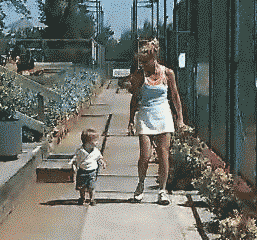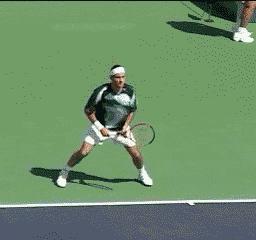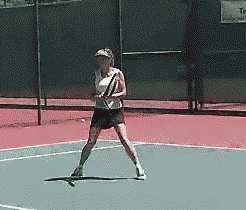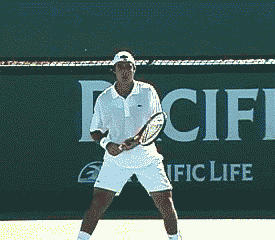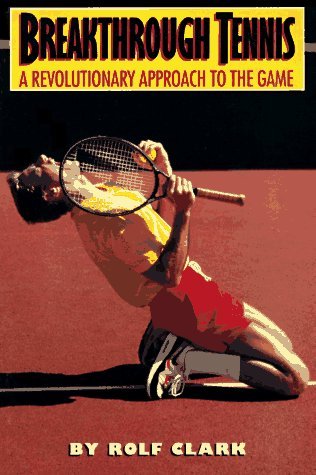|
TennisOne Lessons Exploration: The Learning Tool Rolf Clark To make a real breakthrough in your tennis game you may need to be able to "explore" your play. Exploration means inquiry into the action you are trying to master. Inquiry means we use trial and error to see what works. What feels good. We learn lots of difficult things that way.
When I tired to teach my daughter to ride a two-wheeler, I told her what to do with her hands, where to put her feet, and what to do with her knees. But listening to what I told her didn't help her. She learned how to ride by exploring balance. She got on the bike and struggled with balance until, through trial and error, she got it. We learn to walk by trial and error -- getting up, falling down, getting up -- until we stay up. Our parents didn't explain walking to us. We saw others walk, and walking became a possibility. We explored the possibility. We didn't copy the mechanics of anyone's walk. We walked our way. Exploration, not description, helped us walk and ride bikes. Tennis demands the same. You explore something in your tennis game by observing how you do it -- by becoming aware of what you do -- and experimenting until it feels right. Exploring requires being mentally aware of your physical sensations. Your mind observes and your body senses. If the sensations are less than perfect, you keep experimenting. Learn to Learn for YourselfMany of us learn tennis by taking lessons. The lessons help, but after a while things go wrong again so we take another lesson. We come to rely on the instructor to tell us what's wrong without being actively engaged in that question ourselves. Between lessons, when the instructor is not guiding us, our tennis goes downhill. It shouldn't be that way. We should be able to improve all the time, building on what the instructor tells us.
There are things the instructor really can't teach us. Like balance. You need to feel balance. And while instructors can coach you on timing, they cannot really explain it. You need to sense timing yourself. Tennis professionals seldom have trouble with their timing or their balance. Learning about balance and timing from someone who has no trouble with either can be like learning about water from a fish. The fish doesn't know there is such a thing as water. To really help you, an instructor needs your assistance. You need to let the instructor know how things feel. As you express yourself, you and the instructor become more aware of things to explore. You can explore tennis on your own as well as through lessons. Learn to be involved in the lessons. Don't rely the instructor to be responsible for your learning. Let the pro know what seems to make sense and what doesn't, how you need time to work on this or that before trying something else. Good pros will want this kind of information. Awareness Is Part of It In our culture, we count on succeeding through analysis, explanation, and action. We are oriented toward establishing goals and attaining them on time, by focusing our effort on the process that leads to the goals. This works well when the task is well-defined, like assembling a cabinet or filling out your income tax forms.
It doesn't work at all well when the process being explored is not well-defined. Like walking or riding a bike. Or the complexities of tennis, like timing and balance. Such things lend themselves to exploration, not description. Timing and balance cannot be explained or described well. They must be sensed. You May Need to Rethink the Way You Think Normally we see a problem and want the answer. That doesn't work in tennis. One reason answers aren't the answer is that once you have an answer you stop inquiring into the process to find the real answers. If you believe that "bring the racquet back early" cures your problem of hitting late -- and it may well cure it temporarily -- then you will stop exploring the feeling of lateness in your swing, and never get to the real source of your problem. The true cause of the problem could be your failure to react, or your failure to concentrate on the impact point. Or it could be that you are too close to the ball or are making other basic errors that disrupt your game. There are things that will make a difference in your tennis if you think of them - things that are specific to you or the way you move and concentrate, things that you may not have thought of thinking about. I don't know the dimensions that will cause breakthroughs for you. Only you can find them for sure. But I can give you examples that may help. Not until I explored “concentration” carefully did I find that my mind was not on hitting the ball but instead on where I wanted to hit it to. That's when I started to understand that "watch the ball" was not enough. My eyes could be on the ball while my mind was on the open court I was trying to hit to, which of course distracted me from hitting properly. I was not focused. I was not concentrating on hitting the ball, but rather part of my attention was on where I wanted the ball to go. Not until I explored what it would feel like to hit a perfect shot each time did I ask questions about timing, and what good timing would feel like in my swing. That got me out of the charted waters of forehand and backhand technique , and into the new waters of smooth timing. Timing wasn't embedded in the mechanics I'd spent several years trying to learn. My technique had become quite mechanical, not pendulum-like.
Not until I thought about why men older and heavier than I could reach balls that I couldn't did it occur to me that there was a dimension called "reacting to the ball" that made a big difference. Exploring the concept of reacting and how to speed it up, made me react more quickly. The way one bounces before and as the opponent hits has a lot to do with how quickly one reacts. For example to be just coming up off a bounce as the opponent makes contact lets you move in the correct direction a half second earlier than delaying your bounce until after the opponent hits the ball. Exploring balance led to payoffs, especially on serves and overheads. Being balanced seems to be particularly crucial to hitting any ball above your head. I can't chart a specific path for you to explore. It will be different for each reader. But certain dimensions seem important. Timing and balance deserve your inquiry. So does the concept of concentration and what it is. Another dimension worth exploring is power hitting. Being aware of how you transfer your weight and racquet speed to the ball can have major payoff. Observing your “wristiness” can yield results. A too wristy swing leads to many errors. Your weight transfer as you serve is important. See if your momentum on the serve is up and through the ball instead of sideways and across the ball. As you explore, don't try, at first, to change or correct anything. Just be aware of what is, don't yet judge what ought to be. The exploration will lend its own results. Your comments are welcome. Let us know what you think about Rolf Clark's article by emailing us here at TennisOne.
|

